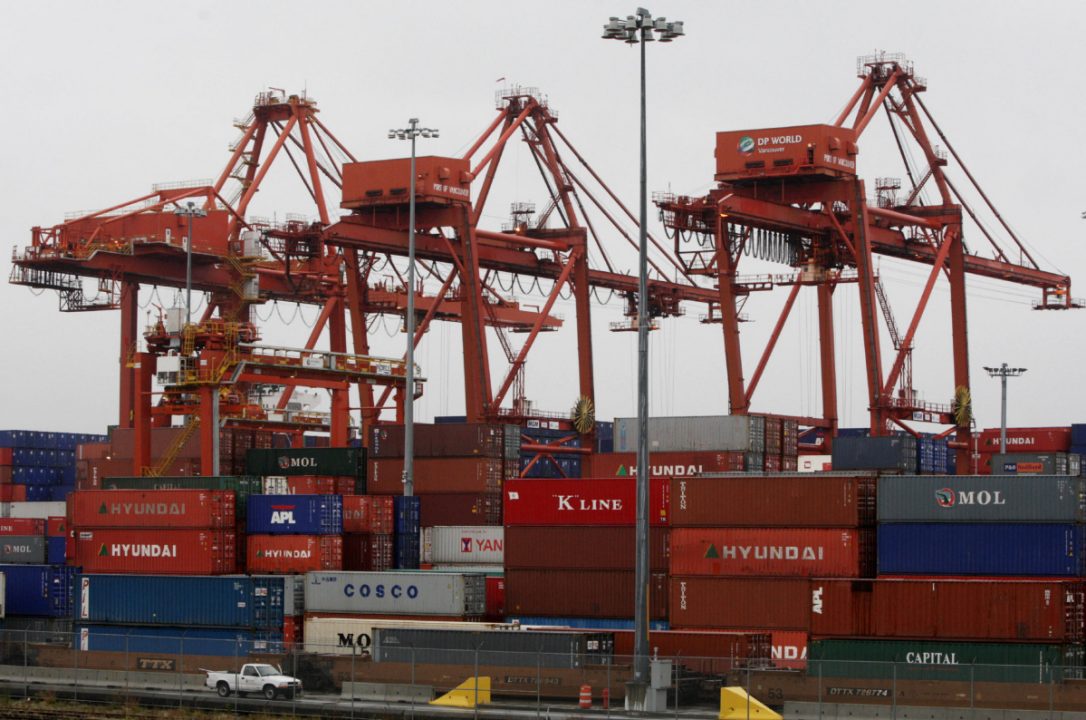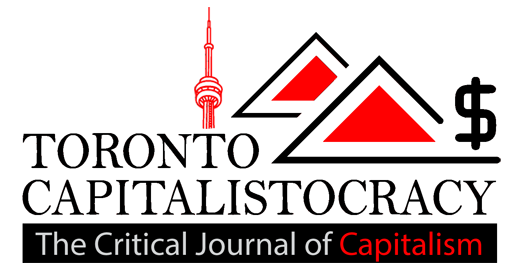Business
Canada’s Export Slump Among Worst in the World

Canadians like to see themselves as the perennial optimists of global trade, even now as questions mount almost everywhere else over the benefits of open economies.
But it’s getting awfully hard.
The country is struggling to emerge from a 15-year slump in exports — among the worst track records anywhere. And with globalization trending in the wrong direction, it may be a bad time to look for an export recovery as governments elsewhere turn away from the free-trade ethos that’s prevailed for the last two decades.
It’s gotten to the point where Prime Minister Justin Trudeau has begun touting online sales of lobsters and cherries to China, and central bank officials are pinning hopes on the next big thing: the surely-imminent flood of global business for the nation’s digital firms.
Maybe better times will come, but the permanent loss of export capacity partly due to last decade’s commodity boom is starting to become a prominent theme for economic policy-makers — none more so than Bank of Canada Governor Stephen Poloz, who makes his next interest rate decision on Wednesday — discouraged by the long-awaited, never-realized manufacturing rebound.
That’s because data right now show a trading nation that’s forgotten how to trade.
In 2000, Canada was by far the most trade-dependent country in the Group of Seven, and one of the most among industrialized countries, with combined imports and exports making up 84 per cent of gross domestic product. That ratio has fallen by about 20 percentage points. The country’s export growth rate, averaging just below 1 per cent in volume terms since 2000, is the worst in the Group of 20 and second-worst among developed economies.
As a share of GDP, Canadian exports have fallen 14 percentage points since 2000 and have been hovering at about 31 per cent in recent years, levels unseen since the North American Free Trade Agreement (NAFTA) came into force in 1994.
Imports are also dwindling in significance. They accounted for 38 per cent of GDP in 2000, and that figure is now 34 per cent.
Things started looking a little better in some sectors in recent years, particularly after the currency started to weaken along with oil in mid-2014, but the nation’s trade performance recently took a new hit. In 2016, exports are rising at the most sluggish pace since the recession.
There were many reasons for the poor performance, which Bank of Canada deputy governor Larry Schembri summarized in a recent speech.
However there’s no denying surging commodity prices played a key role by driving the exchange rate from a record low in 2002 to a record high five years later, pricing many manufacturers out of business.
Some, including OECD economists, expressed concern at the time that Canada’s energy boom would lead to a so-called Dutch Disease. Those worries were brushed off by policy-makers such as former Bank of Canada Governor Mark Carney, largely on the assumption the good times would endure. It didn’t matter if exporters were closing by the thousands. Canada was getting rich.
The picture has certainly changed.
In addition to $60 billion in lost income annually from lower commodity prices, the erosion of export capacity is costing Canada another $30 billion, Poloz said in a Nov. 28 speech, or 1.5 per cent of GDP.
While the causes of Canada’s trade malaise are more or less known, one mystery remains: Why, in the face of a weaker currency and a U.S. recovery, traditional exporters aren’t picking up more of the slack.
One answer: Once exporters leave town — as they have in thousands in Canada — they tend to be gone for good. Or, as Poloz put it at a press conference after the speech: Closed companies are “not like Sleeping Beauty, suddenly they come back.”
“The deeper we dig, the more we find there are pockets of exports that have actually fallen to zero from significant numbers in the past, and those are what we refer to as the lost capacity,” Poloz said. “They closed their doors, and in the economic literature we talk about that as kind of a hysteresis effect, or a scarring effect.”
Canadians — ever the optimists — are keeping an eye on the bright side.
Trudeau is toying with new trade strategies that focus less on selling commodities and more on tapping the global market for consumer goods. The marquee commercial event of the prime minister’s September trip to China was a side visit to Alibaba Group Holding Ltd., China’s dominant online retailer, where company founder Jack Ma launched a dedicated portal for Canadian goods — think lobsters.
Service exports, Poloz pointed out last week, are on a bit of a tear, increasing by a third since 2010 and now generating more than $100 billion in receipts for the country.
And if economies everywhere are turning inward, and the political pressure is for countries to be more self-sufficient, perhaps Canada getting a head start will be a silver lining.
In the meantime, even the optimists aren’t predicting an export renaissance. While the IMF estimates Canadian exports will grow by 2.9 per cent annually between 2017 and 2021 — three times the pace of the previous 15 years — that will still be below the G-7 average.
As for finding new markets, Trudeau’s trade record is more likely to look like a “saving-the-furniture” exercise than anything that resembles the next big thing, as he confronts a growing wave of protectionism, especially if U.S. President-elect Donald Trump follows through on his promise to reopen NAFTA.
The biggest lesson from Canada’s trade performance may be that once your exporting sector falls asleep, it’s tough to wake it up.
Business
Beauty Week is back at Hudson’s Bay in Toronto and it’s time to get glam

Beauty enthusiasts rejoice! Beauty Week at Hudson’s Bay is back in Toronto for another year. It’s time to stock up on all of your fall essentials and, maybe discover some new ones.
From Friday, August 18 to Sunday, August 27, you can expect a truly elevated beauty experience in-store with incredible special offers, limited-time gifts, and exciting activations.
If you’re a diehard beauty lover, you’ll already know that Hudson’s Bay is the place to shop thanks to its extensive range of over 195 skin and makeup brands from both luxury labels and masstige brands — including Tata Harper, Estée Lauder, YSL, Nars Cosmetics, Bobbi Brown, and so much more.
Throughout The Bay’s Beauty Week, visitors can take in some at-counter activations and interactive expert-led tutorials, where there will be chances to get makeup touch-ups from top-tier brands, try a spritz of the most alluring fragrances, and sample tons of new products.
This year’s Beauty Week highlight is the ‘Best in Beauty’ tote, a meticulously-curated selection of 30 deluxe samples from an array of top-tier brands like Dr. Barbara Sturm and Shiseido spanning skincare, fragrance, and makeup — all in a super sleek bag.
The tote, which is valued at over $300, is retailing for just $39 and is a fantastic way to explore new products (without breaking the bank). However, there is a limited quantity, so if you want to get your hands on one, you’ll need to be fast.
Wondering exactly what Beauty Week’s free gifts with purchases entail? If you spend over $95 at Lancôme, you will receive a six-piece set valued at $130. Or, you can get an Estée Lauder gift valued at $170 with purchases over $80. (And that’s just to name a few.)
If you’re a Hudson’s Bay Rewards member, you’ll also get $20 in Hudson’s Bay rewards when you spend over $100 on beauty.

Business
The Canadian Armed Forces are hiring for several non-combat military jobs

The Canadian Armed Forces (CAF) have several non-combat jobs, some of which do not require a college degree or past work experience.
Life in the forces has several benefits, such as paid education plans (college, university and graduate-level programs), 20 paid vacation days, health and dental coverage for you and your family, maternity and paternal leave, and pension plans. You can learn more about the benefits in detail here.
And to make it easier to gauge if you qualify, the listings also include related civilian jobs to see if it’s your ideal role.
Financial services administrator
Related civilian jobs: Financial records entry clerk, financial manager, accounting technician, bookkeeper, budget officer, cashier clerk, business planner technician, and verification manager.
Description: You’ll help budget resources for all military activities besides providing financial assistance.
Education: You need to have completed Grade 10.
Duties: As a financial services administrator, you’ll be responsible for bookkeeping and managing budgets. You’ll also provide support in accounts payable and accounts receivable.
Work environment: Those in this role work at CAF bases, on ships or overseas. You might also be expected to help special operation units, recruiting offices, schools, and medical organizations.
Postal clerk
Related civilian jobs: Mail clerk, mail sorter.
Description: You’ll provide postal services to members and their families at bases and establishments.
Education: Grade 10. No previous work experience or related career skills are required.
Duties: As the postal clerk, you’ll handle mail duties.
Work environment: Besides a postal office, you may work on a ship or a mobile postal van. You might be expected to serve with Royal Canadian Navy, the Army, and the Royal Canadian Air Force in Canada and abroad.
Dental technician
Related civilian jobs: Dental assistant, dental hygienist.
Description: You’ll be helping dental officers provide dental services to CAF members, their families, and dependents.
Education: Level II dental assisting diploma from an accredited college or a National Dental Assisting Examining Board (NDAEB) certificate.
Duties: Those in this role will be responsible for various responsibilities, including disinfection and sterilization of dental equipment, applying rubber dams, placing cavity liners, and controlling bleeding. In addition, you’ll assist in laboratory procedures like creating casts, custom trays, and mouthguards.
Work environment: This role will require you to work in a military dental clinic, a Mobile Dental Clinic, an Air Transportable Dental System, or onboard a ship. You might be expected to work on a base in Canada or other operations in other parts of the world.
Human resources administrator
Related civilian jobs: Records administrator, data entry supervisor, receptionist, office manager, executive assistant, payroll clerk, and information management technician.
Description: Provide administrative and general human resources support.
Education: Grade 10. No previous work experience or related career skills are required.
Duties: In addition to human resources administration and services, you’ll be handling pay and allowances, managing automated pay systems, and maintaining personnel records.
Work environment: HR administrators work at all CAF bases in Canada. They also work on ships and overseas to support the Canadian Army, Royal Canadian Navy, or Royal Canadian Air Force operations.
Medical assistant
Related civilian jobs: Emergency medical responder, ambulance and first aid attendant, registered nursing assistant, licensed practical nurse, and hospital orderly.
Description: Successful candidates will help treat the sick and injured in CAF units. You’ll be assisting and supporting nursing and medical officers.
Education: Minimum of Grade 11 biology, Grade 10 physics or chemistry, and Grade 10 math.
Duties: You’ll provide initial care and essential life support treatments in trauma cases. You’ll help with health assessments (hearing and vision tests, perform basic lab procedures, etc.) and initiate and manage medical records and reports. You’ll also be expected to provide support and first aid during training exercises.
Work environment: Medical assistants may serve with the Royal Canadian Navy, the Royal Canadian Air Force or the Canadian Army as part of the Canadian Forces Health Services Group. Those in this role are exposed to the same risks as the forces they support.

Business
Porter’s new loyalty program promises to match Air Canada’s Aeroplan status

Porter Airlines is once again stirring the pot among Canadian airline rivals, now going after Air Canada’s Aeroplan members by offering to match their loyalty status to an equivalent of their own.
The beloved airline, which recently ranked as having the best cabin service in North America, challenged the competition for the second time this year, after previously deploying a similar tactic against WestJet in the spring.
Earlier in April, Porter presented customers with a limited-time offer to match the loyalty status of WestJet’s patrons with VIPorter levels.
Now, they’re offering Aeroplan members to seamlessly transition to an equivalent VIPorter Avid Traveller status based on their existing membership tier.
Members can then take advantage of an array of travel perks that come with flying Porter, including seat selection, baggage, and flight changes.
For those currently holding an Aeroplan membership, there are two ways to acquire the Avid Traveller status for the rest of 2023:
Status-Based Match:
- Aeroplan 25K members = VIPorter Venture
- Aeroplan 35K members = VIPorter Ascent
- Aeroplan 50K, 75K, and Super Elite = VIPorter First
Flight Segments-Based Match:
- 5 flight segments = VIPorter Passport
- 8 segments = VIPorter Venture
- 17 segments = VIPorter Ascent
- 28 or more segments = VIPorter First
Members will have to first submit their applications on Porter’s website. Registration will remain open until September 6, 2023.
In order to maintain their membership level through 2024, customers will have until the end of 2023 to reach the following reduced qualifying spend (QS) targets:
- Passport = $500 in QS
- Venture = $750 in QS
- Ascent = $1500 in QS
- First = $2500 in QS
Over the past year, Porter has launched an aggressive expansion strategy, including everything from introducing longer flights on newly-purchased jet planes flying out of Toronto Pearson, free WiFi, and a new all-inclusive economy experience.
With Canadians losing both Swoop and Sunwing as WestJet incorporates both into their mainline business, Porter’s direct competition is welcome to keep prices competitive.




